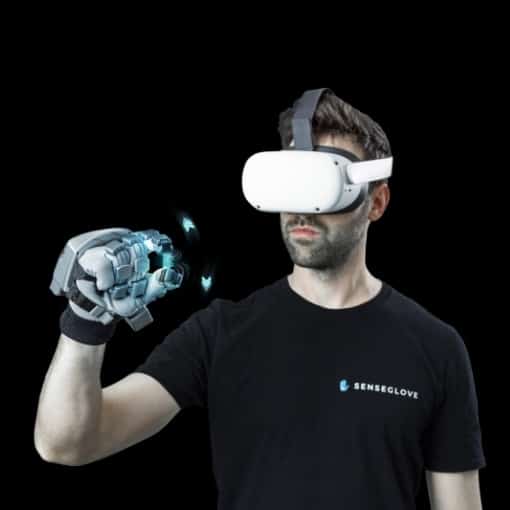Types of Haptic Interactions
The advent of virtual reality has revolutionised how we can interact with digital environments. One crucial element enhancing the VR experience is haptic feedback, which provides physical sensations to users.
Haptics has been thriving and growing since 2010, and the global haptics technology market is expectedto reach £218 million by 2027. Haptic feedback is a type of interaction that provides physical feedbackto the user.
Haptics recreates sensations in virtual worlds, such as vibration, pressure, and density. A haptic glove allows the wearer to use their fingers, control movements and feel the environment and objects in the simulation. In this blog post, we’ll look at some of the most common types of haptic interactions and their applications in virtual reality.
The Power of Touch: VR With Haptic Feedback
Haptics is a form of technology that allows users to interact with digital devices through the sense of touch. From retail to healthcare, VR with haptic feedback is used to enhance the customer experience and create new opportunities for engagement. Users can interact with virtual objects and receive feedback by integrating haptics into virtual reality systems.
Haptics in VR allows users to feel resistance, such as when they hold an object and instantly feel the size and density of an object. Haptics feedback comes in various forms, which we call haptic interactions.
What Are Haptic Interactions?
Haptic interactions refer to the way people interact with computer systems through the sense of touch. They are technical descriptions of each step of a client’s scenario regarding their interaction system. Haptic interactions are categorised as follows:
Contextual Haptic Interactions
This type of haptic interaction is when the simulated environment sends sensations regardless of whether or not the user is interacting with their virtual surroundings. Examples include when raindrops fall, objects come into contact, or environment changes give a sense of danger—the user feels these without taking initial action.
Grounded Haptic Interactions
These are interactions with objects that cannot move freely. Instead, they are grounded to the environment and require an outside force for a motion to happen. These include objects like buttons, doors and levers.
Object-Manipulative Haptic Interactions
These are interactions with objects that can move on all axes in the virtual space. Object-manipulative haptic interactions are classified under:
- One-handed or two-handed – how objects behave depending on how many hands are used
- Object interaction – collision-based interactions (large) and snap-joints or gesture-based interactions (small)
- Passive or active – deformable materials with stiffness or softness (slow) and complex shapes with buttons, like power tools (fast)
Let Us Sketch Your Haptic Interactions
As technology continues to evolve, businesses that harness the power of haptics will be well-positioned to stay ahead of the competition. When clients work with SenseGlove, we first define their use case objectives. We ask questions centred on their return on investment (ROI). These include how they wish to integrate virtual reality into their learning capabilities or production efficiencies.
Most of our clients utilise our services for VR training. The SenseGlove haptic technology is the most crucial element of realistic simulation. Our VR training system is equipped with all haptic interactions fora more holistic and intuitive experience.
Let’s discuss your first haptic use case today.


